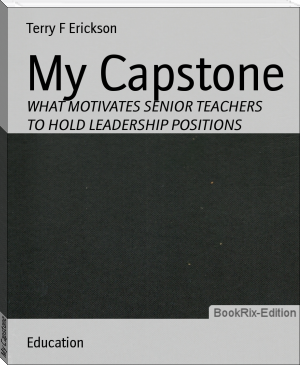My Capstone, Terry F Erickson [classic novels .txt] 📗

- Author: Terry F Erickson
Book online «My Capstone, Terry F Erickson [classic novels .txt] 📗». Author Terry F Erickson
A Piece of Advice
Although my findings didn’t lend themselves to a set of recommendations as I had initially planned, I do have one suggestion to pass along to administrators. Every teacher I interviewed told me that he or she feels honored when an administrator or colleague asks them to do a job or accept a position because of their individual skills and talents. However, the key is to ask them because of personal assets they can bring to the task, not just asking to be a warm body on a committee. Senior teachers appreciate being able to utilize their skills, talents, and interests in areas that they have purposely developed and nurtured over the years. In other words, if Loretta is an expert at teaching reading to primary students, administrators should ask her to take a leadership role in teaching reading at the primary level.
All teachers need some type of external recognition, whether they have been teaching one year or 20. Untenured teachers receive recognition during the yearly review process. However, administrators may take senior teachers for granted and perceive that they no longer need a pat on the back or a few complimentary words. But I found that they do. What better way to recognize and honor a teacher’s years of service, expertise, and passions then to use these in a leadership role?
William Glasser (1997) asserts people are motivated by the need to belong to a group, high self-efficacy or power, and just having fun. In Abraham Maslow’s (1970) hierarchy of needs theory, money is toward the bottom, and recognition and a sense of accomplishment are near the top.
I recommend that principals and administrators form “honor committees” for certain issues that face schools or the district or for work that only experts may be able to accomplish. These honor committees would be much like “blue ribbon” task forces or committees that are established by legislative bodies when high-profile problems must be resolved. Honor committee members would be senior teachers with knowledge, skills, or talents that could be utilized to accomplish the task at hand. The district would benefit from the collective wisdom of the group, and teachers would benefit by being able to use their skills and talents in a meaningful and rewarding manner.
Summary
I have thoroughly enjoyed working on this Capstone for the past eight months. I especially took pleasure in reviewing the literature for Chapter Two and interviewing the nine teachers to collect the data for Chapter Four. I talked with teachers I had never talked with before, and I was in school buildings I had never walked into before---despite teaching for 14 years in the district. I often hear administrators talk about the talented staff we have in my school district, but I have never really appreciated this statement until now. I wish every teacher would have the opportunity to talk with colleagues from other grade levels and buildings about our profession.
I found a sense of responsibility to be the primary motivator, and time to be the primary hindrance for senior teachers. I believe that teachers should be compensated for the extra work they perform in leadership roles but that money will never be a significant motivator. The primary motivator will be the recognition and public appreciation shown by administrators, parents, community members, and students for the dedication and professionalism of all teachers.
References
REFERENCES
Anderson, G. (1998). Fundamentals of educational research. Philadelphia: RoutledgeFalmer.
Anthony, M. (1981). An inside view of shared leadership. Educational leadership, 37, 487-488.
Barth, R.S. (2001). Teacher leader. Phi delta kappa, 82, 443-449.
Bartlett, L. (2004). Expanding teacher work roles: a resource for retention or a recipe for overwork? Journal of education policy, 19, 565-582.
Bishop, H.L, Tinley, A., & Berman, B.T. (1997). A contemporary leadership model to promote teacher leadership. Action in teacher education, 19, 77-81.
Bly, C. (1981). Letters from the country. New York: Harper & Row.
Borders, D.L. (2004) Veteran teachers: the linchpin of school reform. Education week, 24, 30-33.
Bucci, J.A. (2000). Teachers as decision makers: do they have the skills for the task? Kappa delta pi record, 36, 73-75.
Buckner, K.G., McDowelle, J.O. (2000). Developing teacher leaders: encouragement, opportunities, and support. NASSP bulletin, 84, 35-41.
Cherniss, C. (1997). Teacher empowerment, consultation, and the creation of new programs in schools. Journal of educational and psychological consultation, 8, 135-152.
Cowdrey, J. (2004). Getting it right: nurturing an environment for teacher-leaders. Kappa delta pi record, 40, 128-131.
Crowther, F., Kaagan, S.S., Ferguson, M., & Hann, L. (2002). Developing teacher leaders. Thousand Oaks, CA: Corwin Press.
Dirkswager, E.J. (Ed.). (2002). Teachers as owners. Lanham, MD: Scarecrow Press.
Duke, D.L., Showers, B.K., & Imber, M. (1980). Teachers and shared decision making: the costs and benefits of involvement. Educational administration quarterly, 16, 93-106.
Gardner, J.W. (1990). On leadership. In M. Fullan (Ed.), Educational leadership (pp. 3-18). San Fransisco: Jossey-Barr.
Gehrke, N.J., & Romerdahl, N.S. (1997). Teacher leaders making a difference in schools. West Lafayette, IN: Kappa Delta Pi.
Glasser, W. (1997). A new look at school failure and school success. Phi delta kappan, 7, 596-602.
Herzberg, F. (1987). One more time: How do you motivate employees? Harvard business review, 65, 109-120.
Institute for educational leadership (2001). Leadership for student learning: redefining the teacher as leader. Washington, D.C.
Johnson, L.K. (2003). Accelerating the new managers start. Harvard management update, 9, 10-11.
Jones, R. (1997). Teacher participation in decision-making---its relationship to staff morale and student achievement. Education, 118, 76-83.
Kilcher, A. (1992). Becoming a change facilitator: the first-year experience of five teacher leaders. In C. Livingston (Ed.), Teachers as leaders: evolving roles (pp. 58-90). Washington, D.C.: National Education Association.
Lambert, L. (2003). Leadership redefined: an evocative context for teacher leadership. School leadership & management, 23, 421-430.
Lashway, L. (2003). Distributed leadership. Research roundup, 19, 1-3.
Liebman, A., Saxl, E.R., & Miles, M.B. (1988). What skills do educational change agents need? Curriculum inquiry, 18, 157-193.
Leithwood, K., & Duke, D.L. (1999). A century’s quest to understand school leadership. In K.S. Louis & J. Murphy (Eds.), Handbook of research on educational admininstration (2nd ed., pp. 45-72). San Fransisco: Jossey-Bass.
Livingston, C. (1992). Teacher leadership for restructured schools. In C. Livingston (Ed.), Teachers as leaders: Evolving roles (pp. 9-20). Washington, D.C.: National Education Association.
Lofy, B. (Ed.). (2005). Politics the Wellstone way. Minneapolis: University of Minnesota Press.
Maslow, A. H. (1970). Motivation and personality. New York: Harper & Row.
Mertens, S., & Yarger, S.J. (1988). Teaching as a profession: leadership, empowerment, and involvement. Journal of teacher education, 12, 32-37.
Miller, E. (1995). Shared decision-making by itself doesn’t make for better decisions. The Harvard education letter, 11, 42-46.
Mulford, B., & Silins, H. (2003). Leadership for organizational learning and improved student outcomes—what do we know? Cambridge journal of education, 33, 175-195.
Murphy, J, & Beck, L.G. (1995). School-based management as school reforms. Thousand Oaks, CA: Corwin Press.
Odell, S.J. (1997). Preparing teachers for teacher leadership. Action in teacher education, 19, 120-124.
Ogawa, R.T., & Bossert, S.T. (1995). Leadership on an organizational quality. In M. Fullan (Ed.), Educational leadership (pp. 224-243). San Fransisco: Jossey-Bass.
Ovando, M.N. (1996). Teacher leadership: opportunities and challenges. Planning and changing, 27, 30-44.
Pellicer, L.O., & Anderson, L.W. (1995). A handbook for teacher leaders. Thousand Oaks, CA: Corwin Press.
Pounder, D.G., Ogawa, R.T., & Adams, A.E. (1995). Leadership as an organization-wide phenomena: its impact on school performance. Educational administration quarterly, 31, 564-588.
Ramirez, A. (2001). How merit pay undermines education. Educational leadership, 58, 16-20.
Richardson, L.M. (2003). Helping teachers participate competently in school leadership. The clearing house, 76, 202-205.
Ross, J.A. (1995). Strategies for enhancing teachers’ beliefs in their effectiveness: research on a school improvement plan. Teacher college record, 97, 227-251.
Ross, J.A., Hogaboam-Gray, A., & Gray, P. (2004). Prior student achievement, collaborative school processes, and collective teacher efficacy. Leadership and policy in schools, 3, 163-168.
Sergiovanni, T.J. (2000). Moral leadership. In M. Fullan (Ed.), Educational leadership (pp. 242-261). San Fransisco: Jossey-Bass.
Smylie, M.A., Conley, S., & Marks, H. (2002). Reshaping leadership in action. In The educational leadership challenge: redefining leadership for the 21st century. Chicago: National Society for the Study of Education.
Stone, M., Horejs, J., & Lomas, A. (1997). Commonalities and differences in teacher leadership at the elementary, middle, and high school levels. Action in teacher education, 19, 49-64.
Strauss, W. (2005). Talking about their generations. School administrator, 8, 10-14.
Sugar, W.A., & Warren, L.L. (2003). Promoting a teacher/leader-designer perspective for public school teachers. Action in teacher education, 25, 30-37.
Sweetland, S.R., & Hoy, W.K. (2000). School characteristics and educational outcomes: toward an organizational model of student achievement in middle schools. Educational administration quarterly, 36, 703-729.
Taylor, D.L., & Bogotch, I.E. (1994). School-level effects of teacher participation in decision making. Educational evaluation and policy analysis, 16, 302-319.
Taylor, D.L., & Tashakkkori, A. (1995). Decision participation and school climate as predictors of job satisfaction and teachers sense of efficacy. Journal of experimental





Comments (0)